

Denali National Park was one of the top destinations that I wanted to visit on my trip to Alaska. One of the largest parks in America, it remains a nearly unspoiled wilderness yet still accessible to the general public. When I visited Yellowstone National Park a few years earlier, I understood why it's often called the American Serengeti, much like going on a safari and seeing the natural beauty of the American West. Denali would provide a similar experience, only even more remote and less disturbed by human habitation. I had high hopes for Denali, and it did not disappoint.

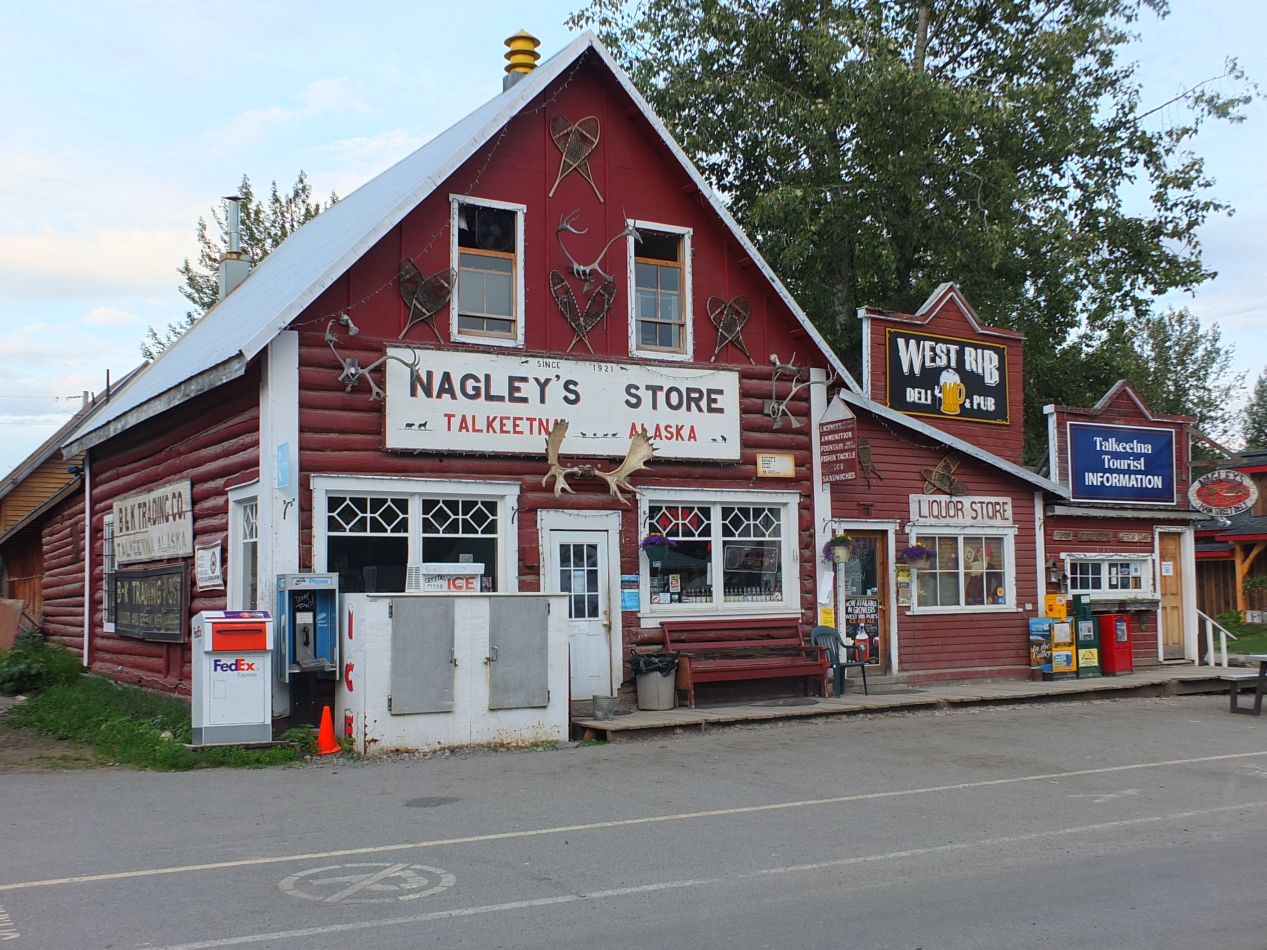


Just getting to Denali can be a minor adventure in and of itself. Although the park is accessible by one of Alaska's major highways, Denali is well over 200 miles north of Anchorage and there are no cities or towns of any size nearby. Some visitors fly into the nearby small airport, and others take the Alaska Railroad, which parallels the highway (the rails were there first) and runs past the park. Mostly people drive though, either up from Anchorage or down from Fairbanks, and that means a lengthy car trip. I had a four hour drive ahead of me, and I needed to be at the park entrance by 11:00 am to catch the bus that I would be taking into the park. That meant a very early start, and I was off by 4:00 am to ensure that I had plenty of time to spare. It was so early that the sky was actually dark outside when I left Anchorage, a rarity in the summer months. It was only a week after the summer solstice at the time of my trip, and Anchorage was getting about five hours of darkness each night. All the places that I stayed had blackout curtains to help visitors get to sleep at night, which can be a bit of a strange experience.
On the drive north I stopped at the historic town of Talkeetna. Originally established to service the trains on the Alaska Railroad, Talkeetna is now a tourist destination that specializes in outdoor recreation activities. This is the place where a lot of prop planes leave to give flyover tours of Denali, as well as the location where groups who are actually trying to climb Denali do their planning before flying up to base camp. There are also all kinds of adventure outfitters located here, along with the quaint buildings of the town that cater to visitors in the summer months. I stretched my legs here, walking around and snapping some pictures of the historic general store, a stopped train from the railroad, and some of the planes. This took place early on a Sunday morning though - I think it was about 6:00 am - and understandably everything was deserted as a result. Talkeetna looks to be a bit of a tourist trap, but it still makes a nice stopping point on the long drive to Denali.

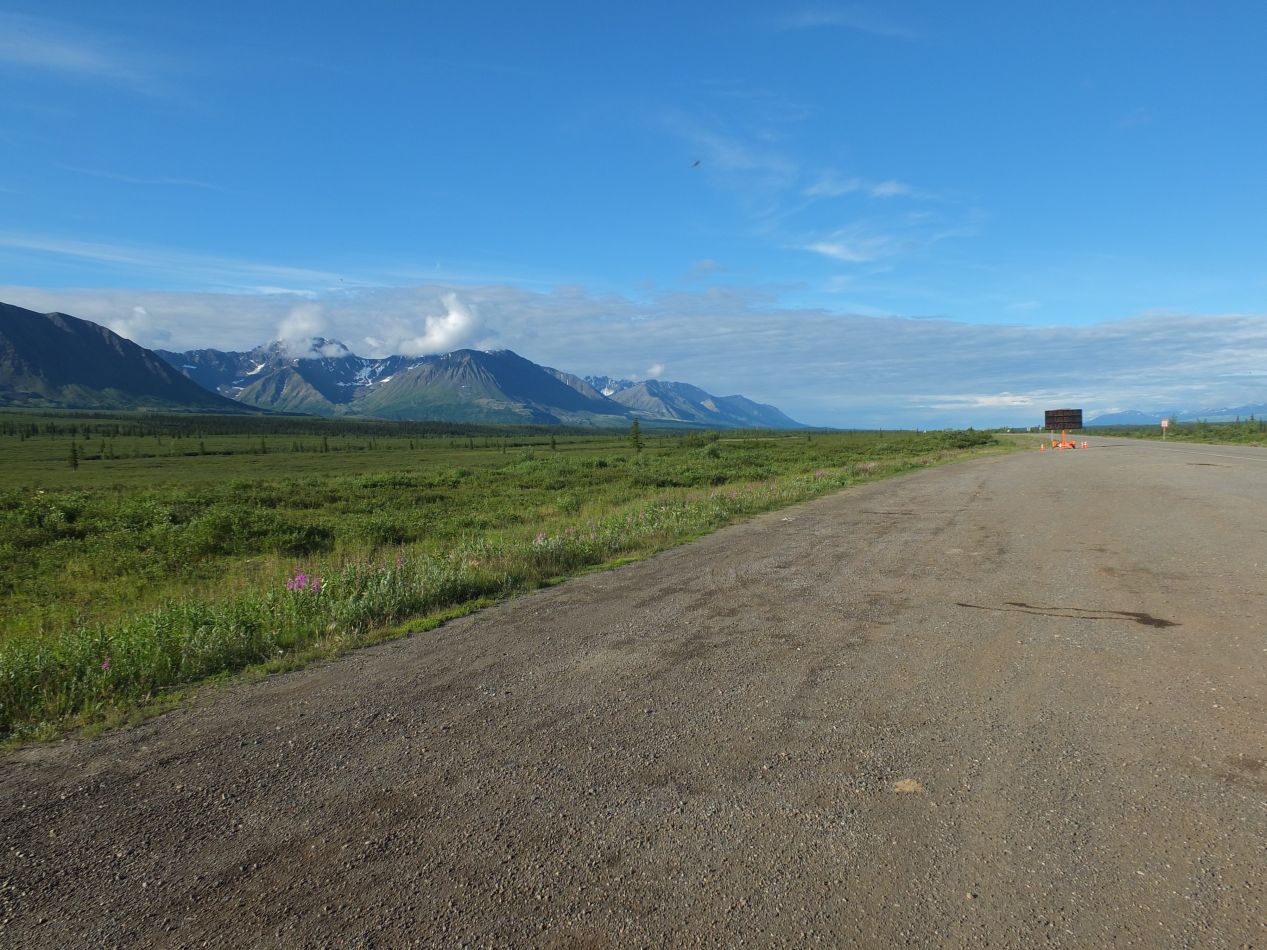


From Talkeetna, I continued to head north for several more hours. One thing that any traveler in Alaska will soon note is the amount of roadwork taking place. The freezing climate takes a brutal toll on the roads, and the summer months are the only time of the year when repairs can take place outside of true emergencies. As a result, the roads are constantly being repaved or resurfaced, which can lead to long delays even on the sparsely populated highways. I also should use the term "highways" loosely; this was Highway 3, the main road between Anchorage and Fairbanks, and yet as the pictures illustrate it was a one-lane road in each directon. The route twisted and turned its way through the mountains while seemingly endless forests of short, tough trees and open meadows passed by on each side. Lakes carved out by glaciers in the recent past dotted the landscape like blue sapphires. Unlike the past two days, the weather today was clear and sunny, with a beautiful sky spotted with puffy white clouds. It was perfect weather for a day spent outside.

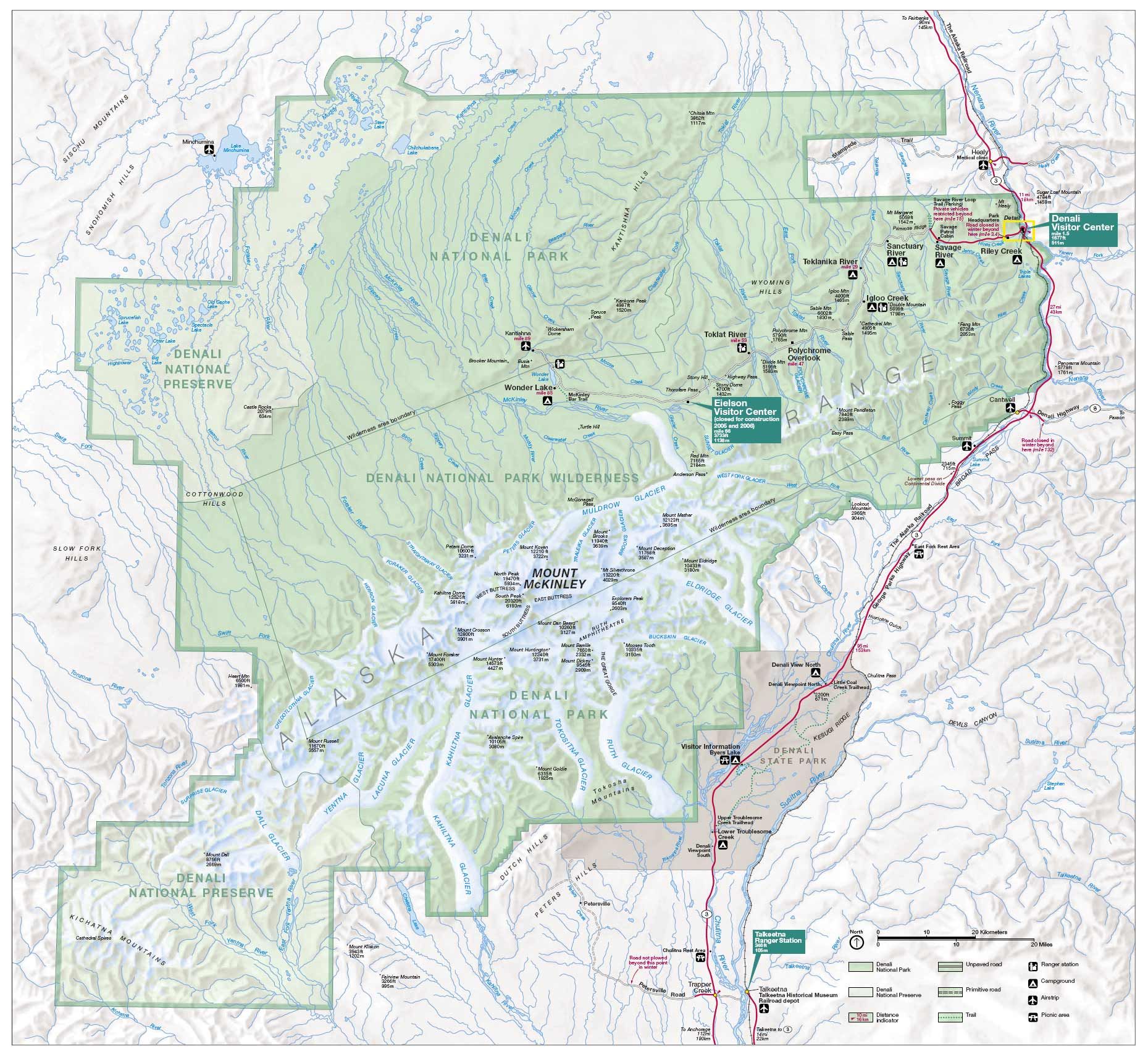


I reached the park itself in midmorning, right on schedule. The first thing to know about Denali National Park is that it isn't organized like most other parks. Unlike Yellowstone or Glacier National Parks, there aren't a lot of roads that run through the protected lands. There is exactly one road in Denali, the Park Road, and private vehicles are only allowed to travel on the first 10 miles of it. The other 90 miles are solely accessible using the park's system of buses, which shuttle back and forth throughout the day along that long and winding path. This is a lengthy distance and the buses don't cross it quickly. Anyone who plans to travel into the park's interior needs to plan accordingly, as a trip to the end of the Park Road needs to allow about eight hours of travel time... and then another eight hours of travel time to get back out again going the other way. The only other ways out are walking or flying on a private prop plane, and neither was in the cards for me.
I've included one of the park maps above to illustrate where the following pictures were taken. I would be traveling to Wonder Lake, 85 miles along the Park Road, where I would be camping for the night. (The need to bring a tent along with me was the heaviest thing weighing down my luggage, although most of the time I was able to keep it in my rental car.) Anyone interested in replicating my journey should be ready to plan ahead though: reservations to camp at Wonder Lake are strictly limited. I had planned this out months in advance and made my reservation in February for this trip taking place at the end of June, and on a Sunday night to boot. Denali doesn't allow anyone to spend the night in the park unless it's been cleared ahead of time. They are highly protective of the wilderness within the park's boundaries.


I had also booked passage on a special camping bus, designed to carry the gear of people who would be staying overnight at one of the park's campsites. The bus was easily identifiable by its green color and missing seats in the rear of the vehicle, where all of our various assorted camping stuff was piled. The bus itself was a low-frills affair, exactly the same as innumerable school buses I had ridden as a child. Everyone grabbed seats by the windows and settled in for the long ride westwards.

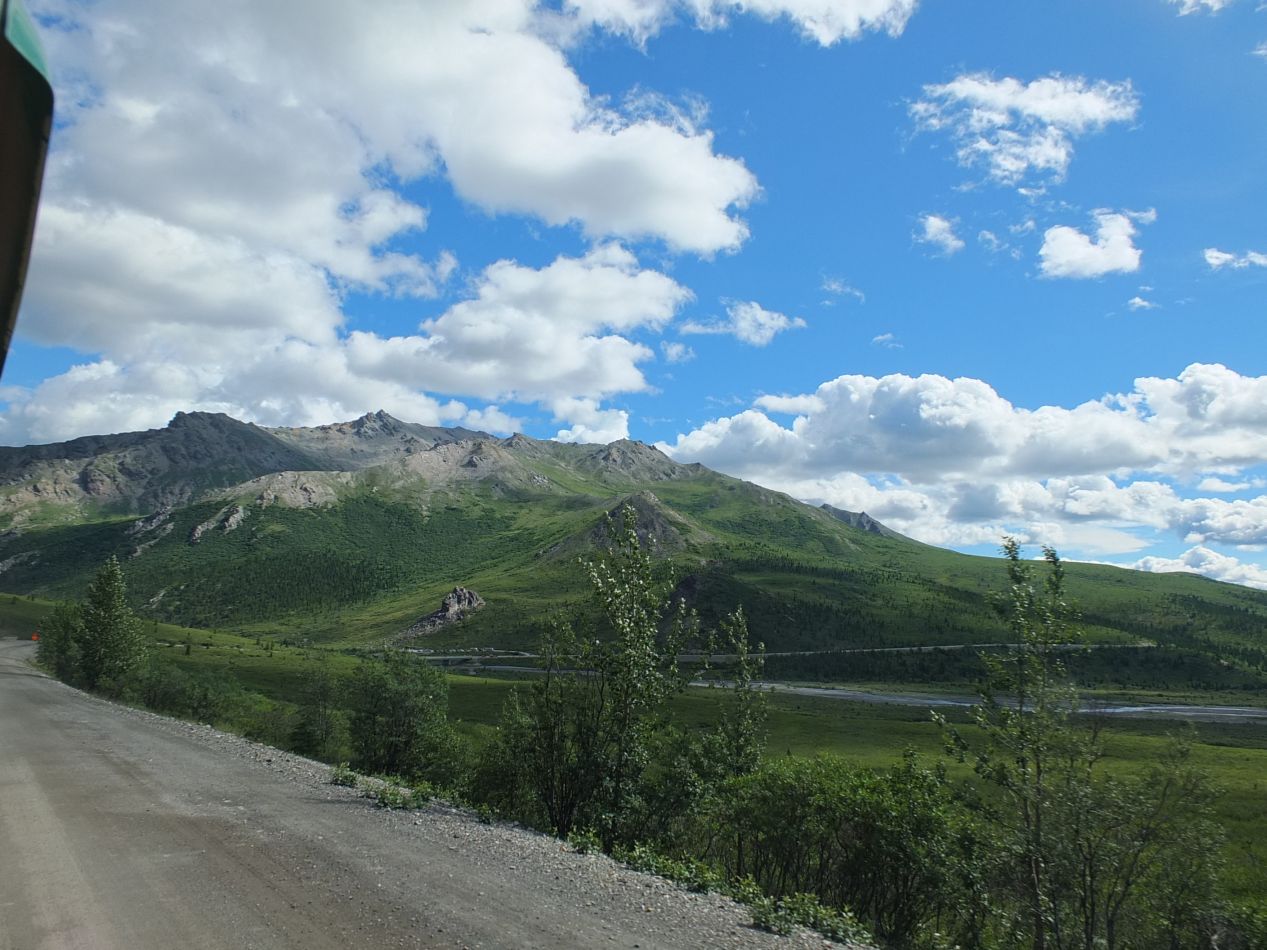


The park delivered up amazing views the whole time that we traveled, of course, and that made the slow journey a true pleasure. We quickly left behind the small area of the park open to private vehicles, and began snaking our way around one curve after another. Small rivers and streams dotted the landscape everywhere, and here in the heart of summer, the terrain was blooming with green growth everywhere. After about an hour our bus reached Sanctuary River, the first stopping point with bathrooms and a small campground. The last two pictures above are from that rest stop, where everyone dutifully poured off the bus to breathe in the fresh air. The Sanctuary River itself looked to have almost dried up, which was common for all of the other rivers in the park as well. The carved out floodplains surrounding the current trickle of water spoke to what the area must look like in the springtime though, when melting snowfall turns these placid streams into roaring torrents. There are a lot of signs in Denali cautioning visitors not to try fording the rivers, as they can be unpredictable and dangerous. But as a veteran of Oregon Trail, I knew all about what happens when trying to ford through rivers. 

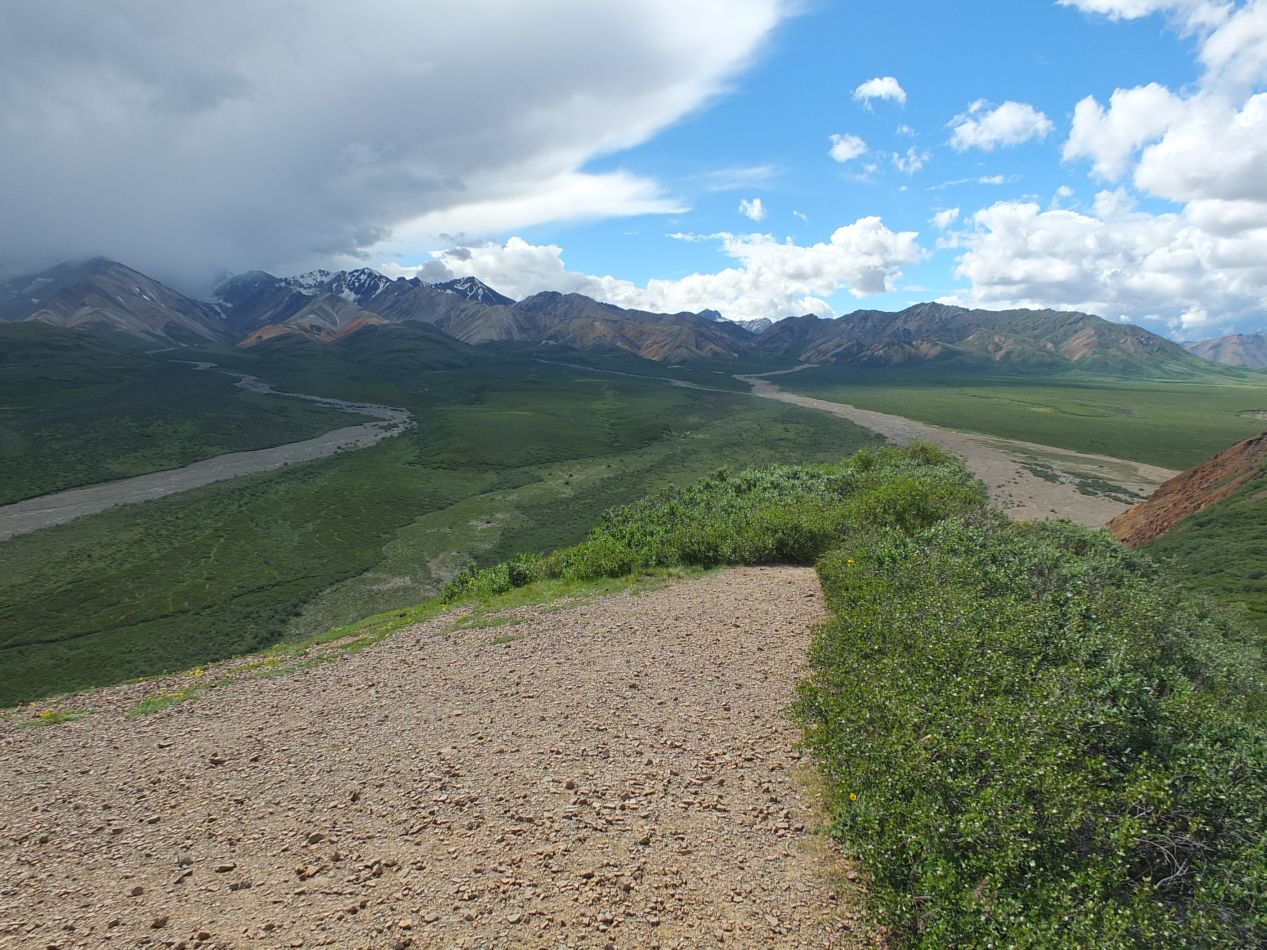


As we continued onwards, more clouds began to roll in and block out parts of the sky above. We stopped next at Polychrome Pass, 47 miles along the Park Road, which was located up on top of a ridge looking down at the surrounding plains. To the southeast from the direction we had come, the sky remained bright and sunny with occasional puffy white clouds. Off to the southwest, however, there was a dark patch of clouds shrouding the mountains in dense fog. The landscape was open enough that we could see the weather patterns moving across the sky, with the mountains influencing what took place in the skies above. The contrast between light and darkness was particularly stark here, and with a storm front coming through I could feel the barometric pressure dropping. We were back on the bus before the rain hit though, and fortunately this patch of bad weather blew itself out pretty quickly instead of sticking around for the rest of the day.
There was also wildlife to spot, with caribou in particular ranging all over the park. I zoomed in to take a picture of a male deer with prominent antlers above, snacking on some tasty summer foliage. I was hoping to see wolves, bears, and moose as well on this trip, but had no luck thus far.

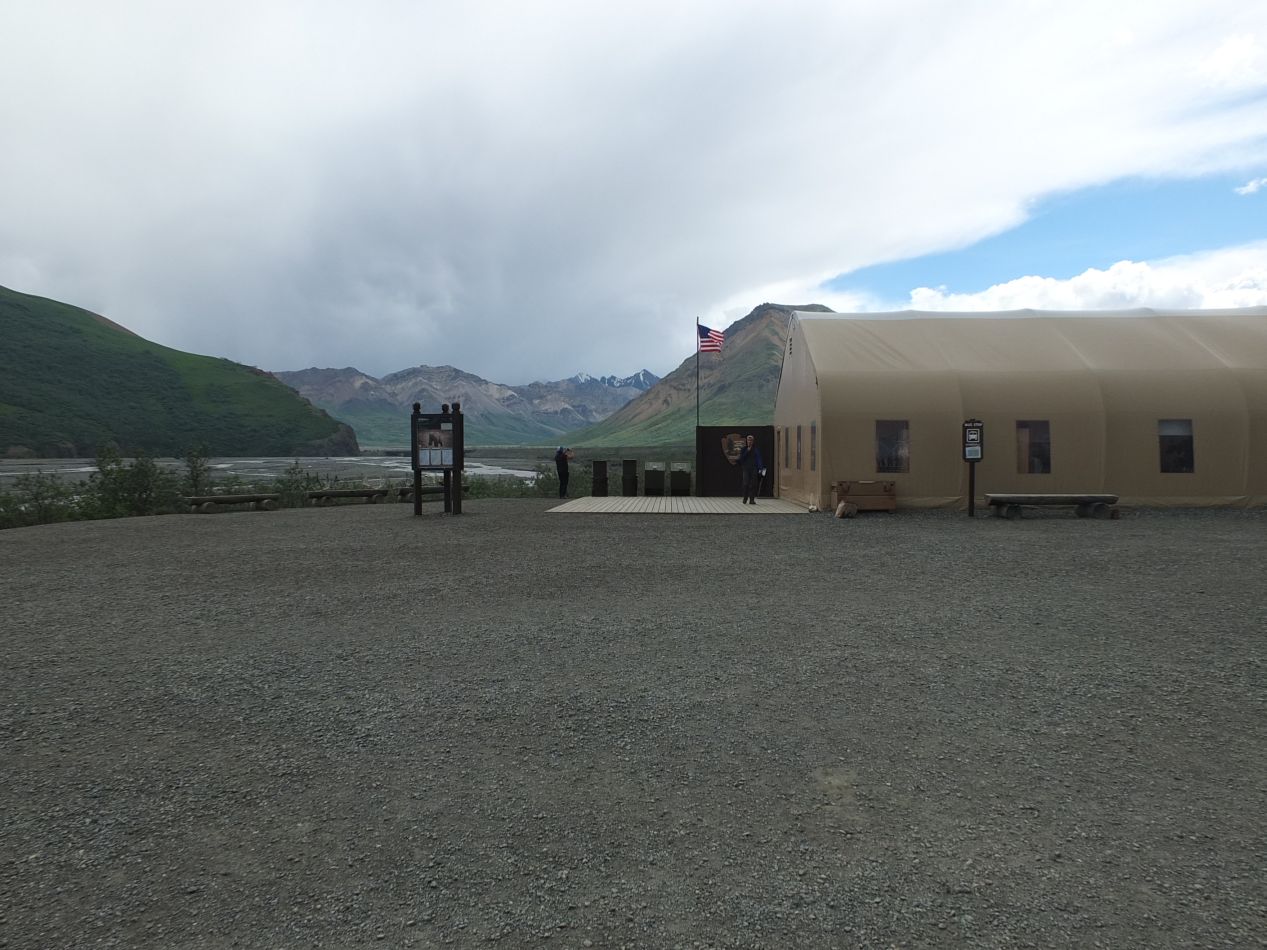


The sky still hung overcast and gray at the time of our next stop at Toklat River, 53 miles along on the Park Road. This was the largest river that we had crossed as yet, and the dark skies along with the sunken riverbed combined to give this location somewhat of a gloomy feel, at least on this particular day. The covered tent pictured above was actually a gift store, believe it or not, there to sell park merchandise to the tourists arriving on buses. Many of the tour buses stop here at Toklat River and go no further into the park; it's still a five hour round trip to come to Toklat and head back to the entrance by the visitor center again. I managed to catch a picture of one of those tour buses just after crossing the bridge and about to unload its passenger cargo. It's one of my favorite images from Denali, with the tour bus dwarfed into insignificance when placed alongside the river in the foreground and the mountains in the background. Our own camper bus certainly fared no better. We were all children here when set alongside the immense proportions of the natural landscape.

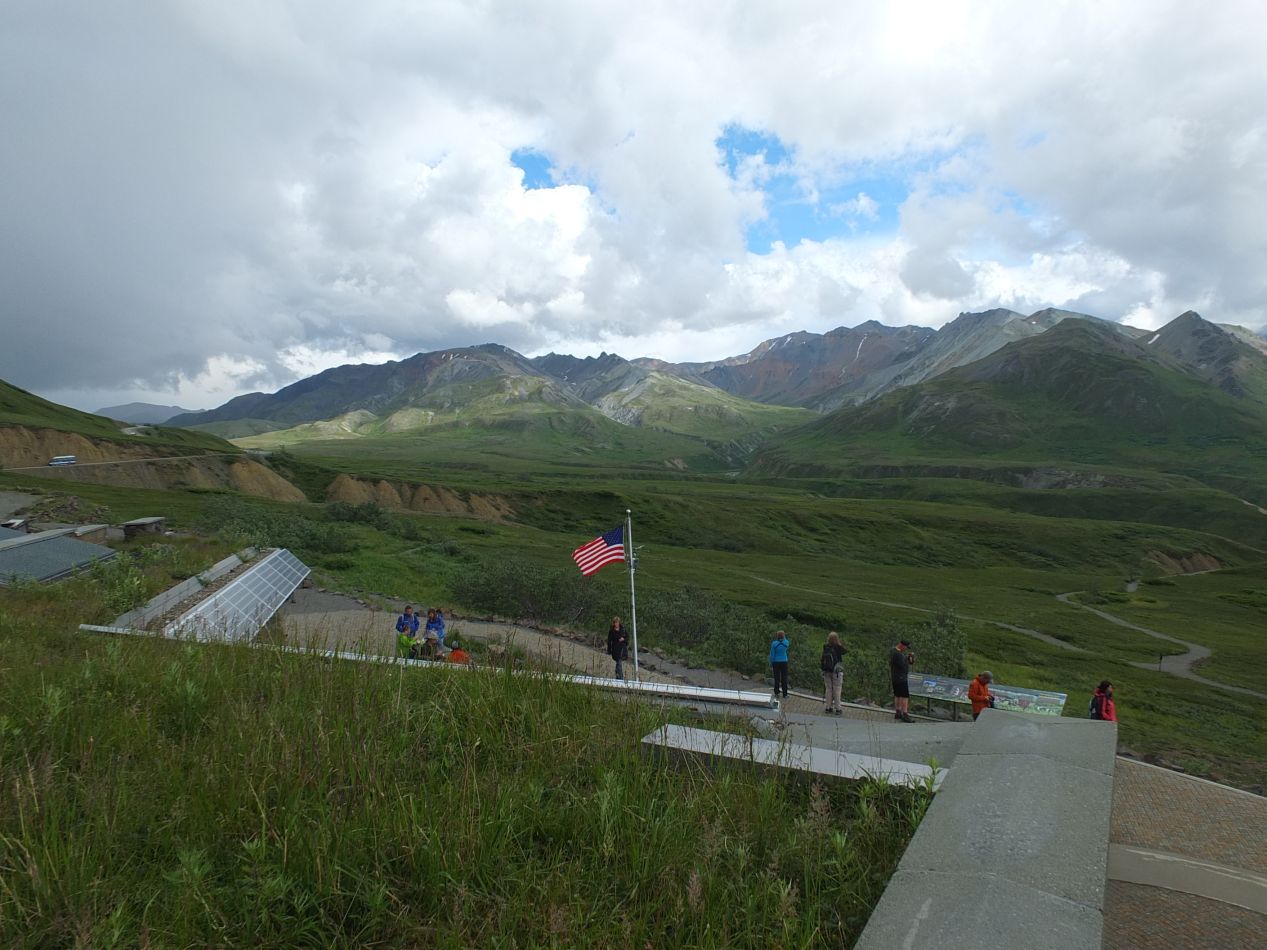


One of the highlights of the park is Eielson Visitor Center, 66 miles along the road and the stopping point for most of the tour buses. Very few of them travel any further given that the time needed to reach this point and return back to the entrance again takes up the better part of a full day. The visitor center itself was impressive from an architectural standpoint, built almost entirely into the side of a hill to minimize the impact on the landscape. The interior holds several small exhibits on the mountains to the south, and in particular on Denali itself, including a short film about the individuals who climb the peak each year. The location of the visitor center was also well chosen by the park authorities, sitting atop a ridge with commanding views of the valley below and mountains in the distance. For whatever reason, there are no trees located anywhere in the terrain below, and the view on a clear day stretches for mile and miles into the distance. There were caribou visible in every direction again, not moving in herds but instead traveling in small groups of ones and twos. The antlers that I saw on them might suggest that they were young males out on their own; I don't know enough about the social structure of these animals to hazard more than a guess.


Then there's the mountain itself that gave the name to the entire park: Denali. Also known as Mount McKinley, the summit of Denali is the tallest in North America by a wide margin at 20,310 feet (6190m). Quite aside from its enormous height, the mountain is unusual for rising up from relatively flat surrounding terrain. The local elevation where we were standing was at about 3000 feet above sea level, which means that Denali rears up roughly 17,000 feet above that. The mountains in the Himalayas are much taller, but they're starting from a much higher base altitude as well. Based on what the visitor center had to report, Denali is the tallest mountain in the world relative to the surrounding elevation. In terms of pure visual spectacle, therefore, this mountain stands out in a way that has few or no equals. Eielson Visitor Center is one of the best places in the park to spot the mountain, but unfortunately it's wrapped in cloud cover nearly all of the time, since Denali's elevation is higher than the altitude at which most clouds hover. I was able to see part of the mountain from this vantage point, however much of it remained shrouded in clouds, and I couldn't get a sense of its true scale. At least I could see Denali at all though. I understand that it's completely invisible on two out of every three days.

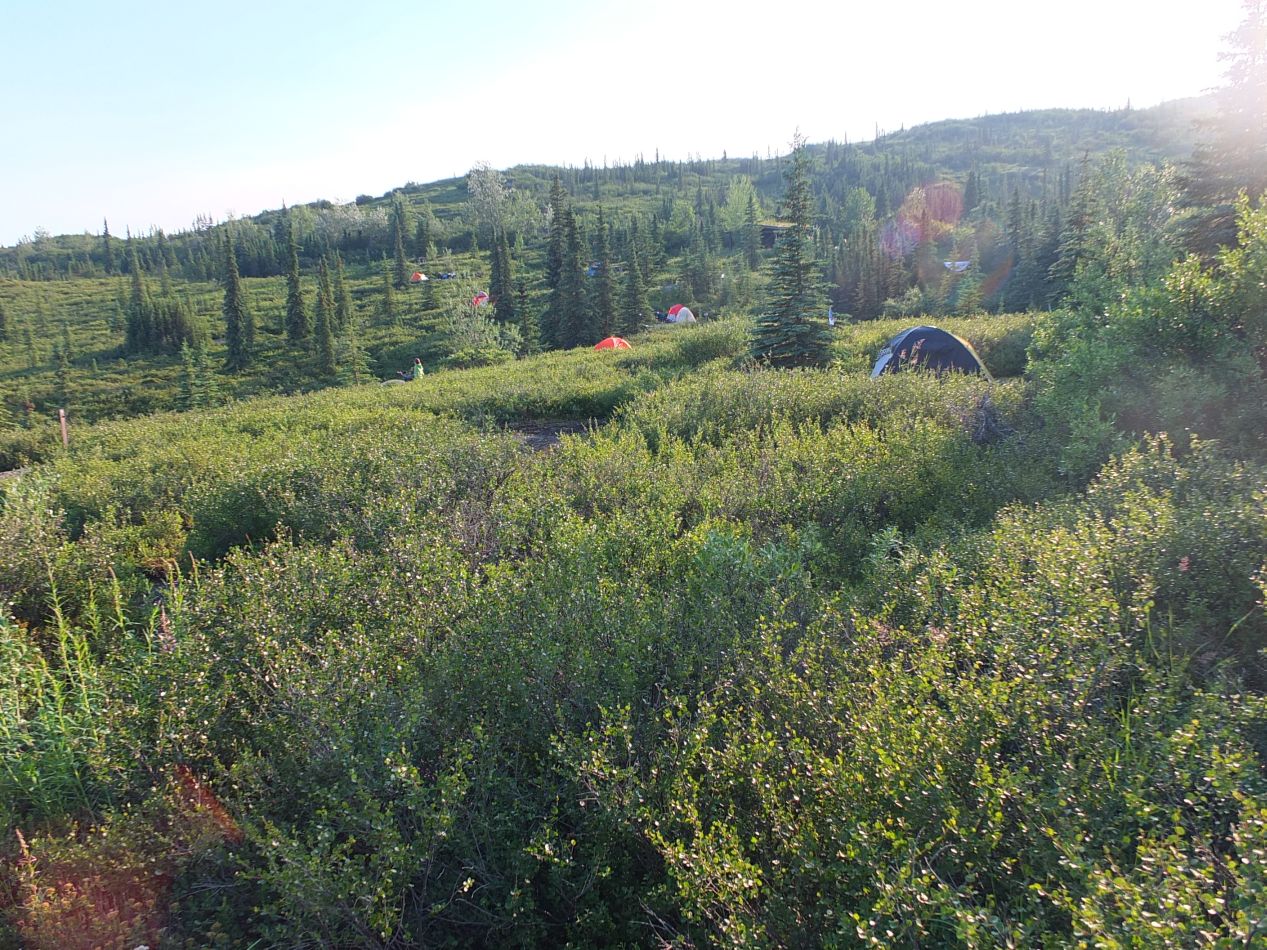


The last stop for me was Wonder Lake campground, where I arrived in the early evening. Located 85 miles from the entrance to the park, Wonder Lake consisted of two dozen locations to set up tents, a basic bathroom, and nothing else. It was rustic and back to nature, just what one would expect. Every campsite was full on this evening, and some of the campers that I had ridden with during the day were kind enough to help me set up my tent. The weather had cleared up nicely by now, and I had quite a view out of the flaps of my tent. If anything, it was too bright outside - the sun wasn't going to set until after midnight!

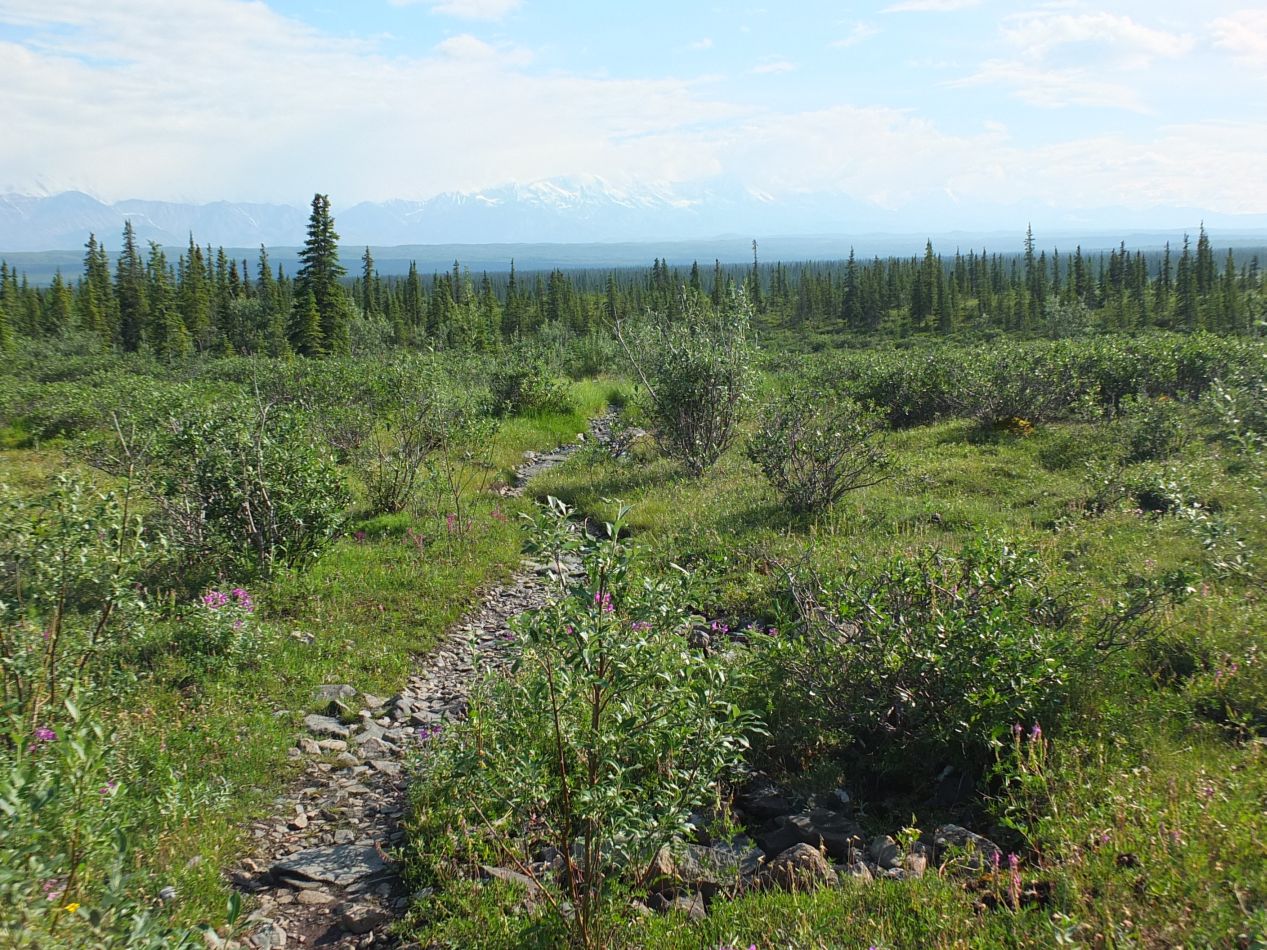


There was a small hike that I had marked out to do this evening after setting up camp, an easy 6 mile roundtrip walk on the McKinley Bar Trail down to the McKinley River. The path was flat and easygoing, crossing over small streams of water and passing squat bushes before heading into a shaded forest of pine trees. I noticed that these trees were relatively short, which had to be a sign of the thin soil and rough winter climate in these parts. The trail was utterly deserted, and I saw no one during the hour's walk down to the river's edge. This was well and truly out in the wilds now, almost a hundred miles away from the entrance to the park and a good distance even from the campground at Wonder Lake.

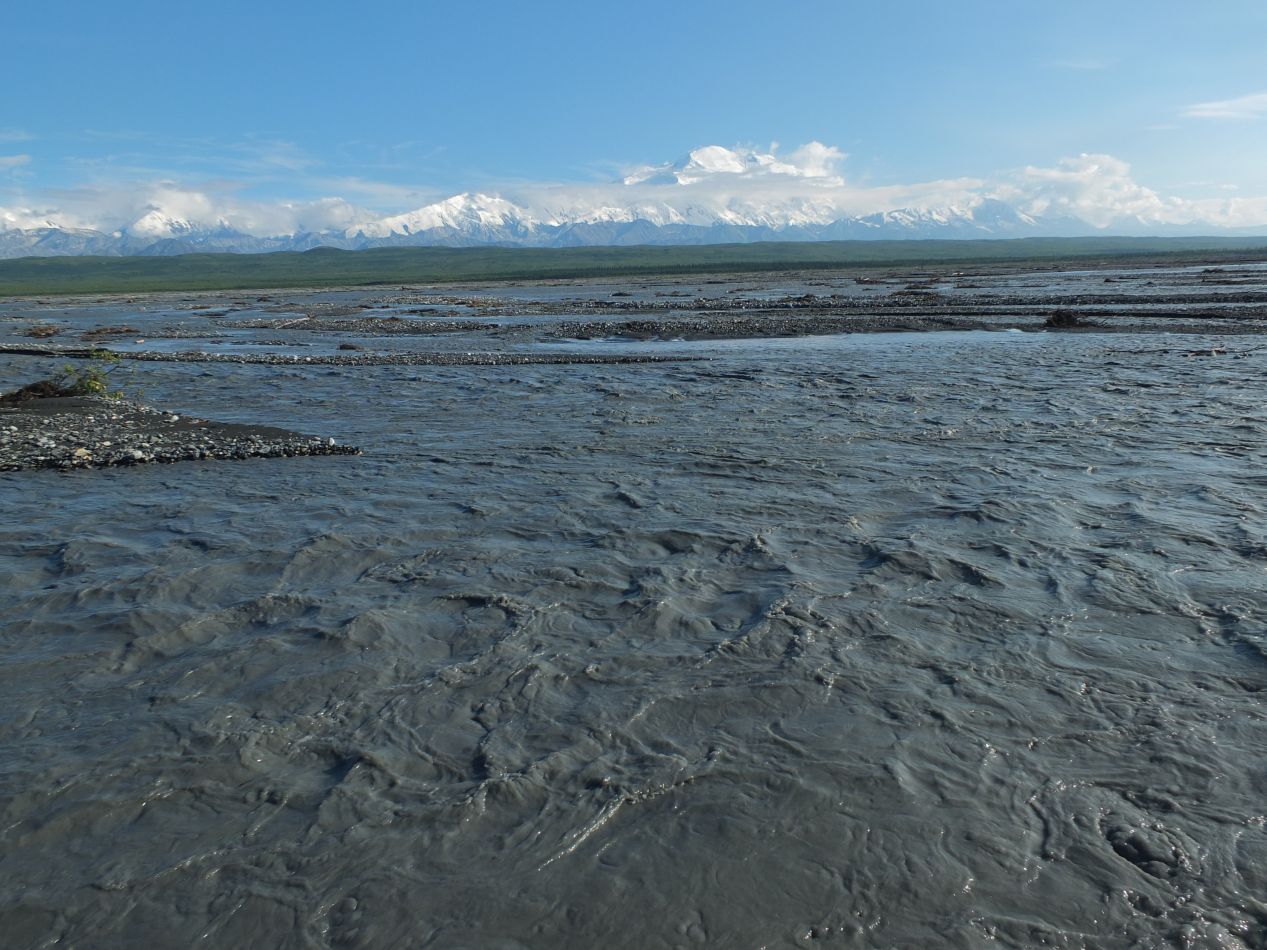


I heard the river long before I saw it, the sound of rushing water somewhere up ahead moving along in a hurry. The trees blocked out vision of what lay ahead, to the point that when I finally turned the last corner and emerged into dazzling sunlight at the riverbank, the scenery hit me square in the face like an unexpected blow. Denali was RIGHT THERE in front of me, and amazingly, nearly all of the cloud cover had vanished, leaving only a few thin streamers to hide the mountain's face. It's difficult for me to put into words the enormity of the mountain, now that I could see it bereft of cover and closer than I had been at any previous point in the park. Denali might look like wasn't that large or wasn't that far away, if you look only at the peak itself. However, there's a serious warping of perspective in these images that only becomes clear when considering the other terrain features captured in the foreground. The trees on the far side of the river look too small somehow, although of course they were normal size, and it was the size of the mountain that was off. In front of Denali, there was another ridge of what appears to be small foothills - those were actually a range of mountains themselves at roughly 5000 foot height, dwarfed into insigificance by the monster to their south. It might also be useful to point out how far away I was from Denali in these pictures: the mountain looked to be close, but was actually about 25 miles away. I honestly thought the top of the mountain was a cloud formation at first, because a lifetime of living on this planet teaches you that terrain formations simply do not appear that high up against the horizon. The bulk of Denali was nothing short of incredible. It seemed to block out a sizable chunk of the sky. This was a quasi-spiritual experience for me, having traveled so far out into the wildnerness into utter isolation, and then to be granted a perfect clear vista of Denali under the light of the Midnight Sun... well, it made the whole trip worthwhile. 


I don't take very many pictures of myself while traveling, but I took one here, after a series of trial and error with my camera. I'll always remember this spot, the beautiful view of Denali from the muddy riverbanks at the end of the McKinley Bar Trail. On my way back up the trail, I looked back and snapped one last amazing picture of the peak, this time rearing over the pine forests instead of the river. I had the same feeling as when I visited the Grand Canyon many years ago: Denali looked like a fake background from here, a painted scene used as the setting in a movie. Sometimes it's hard to believe that these kind of natural formations really exist in the wild.
Camping that night wasn't the most fun I've ever had. Because of the need to travel light, I had little in the way of proper supplies, and the temperature dropped lower than I expected during the brief night period. I was up again very early around 5:00 am with the need to ensure that I was on the first bus back to the park entrance. The second one wouldn't arrive for another four hours, and that would kill my whole day. Waking up so early has its own advantages though sometimes:

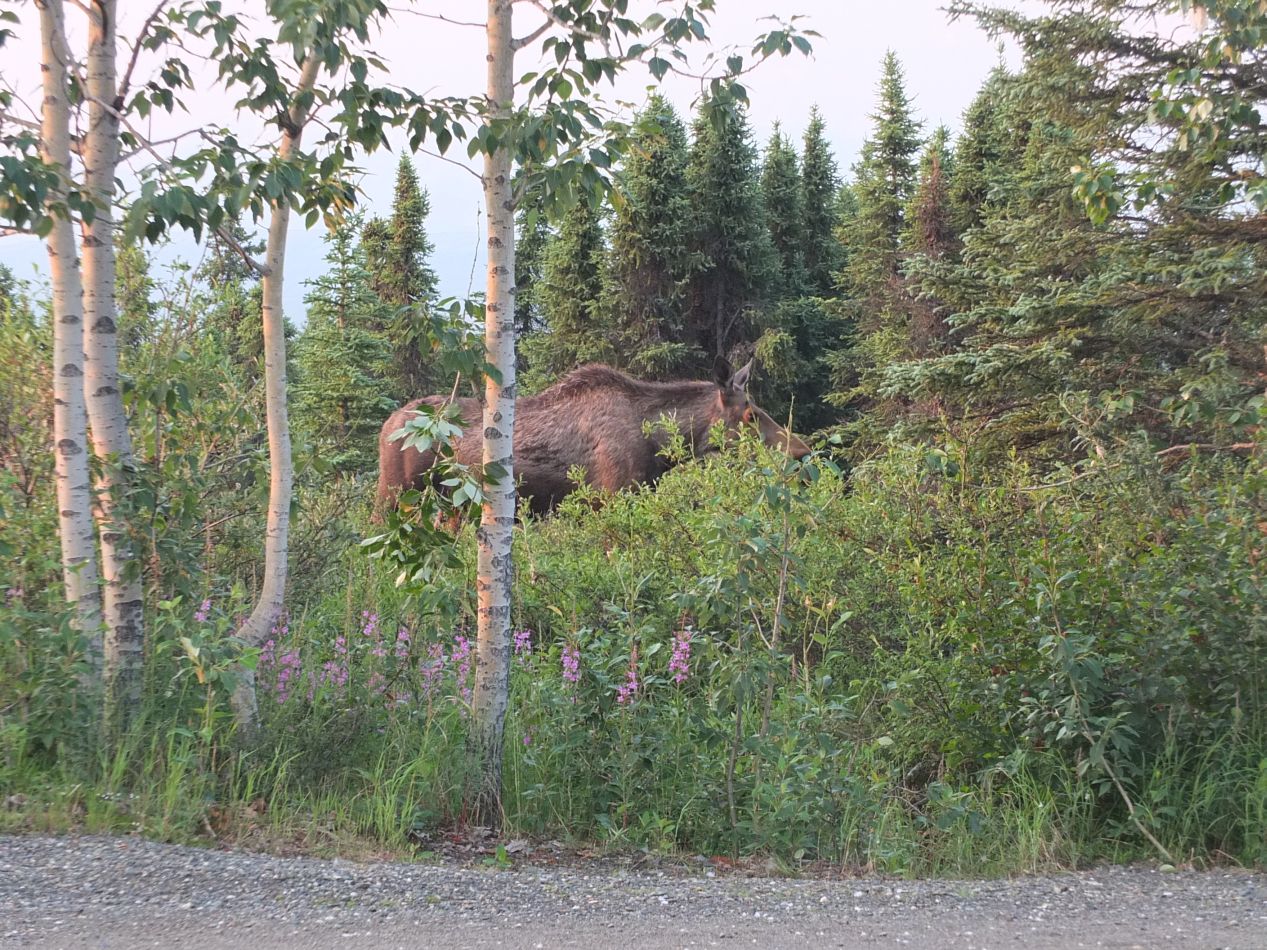

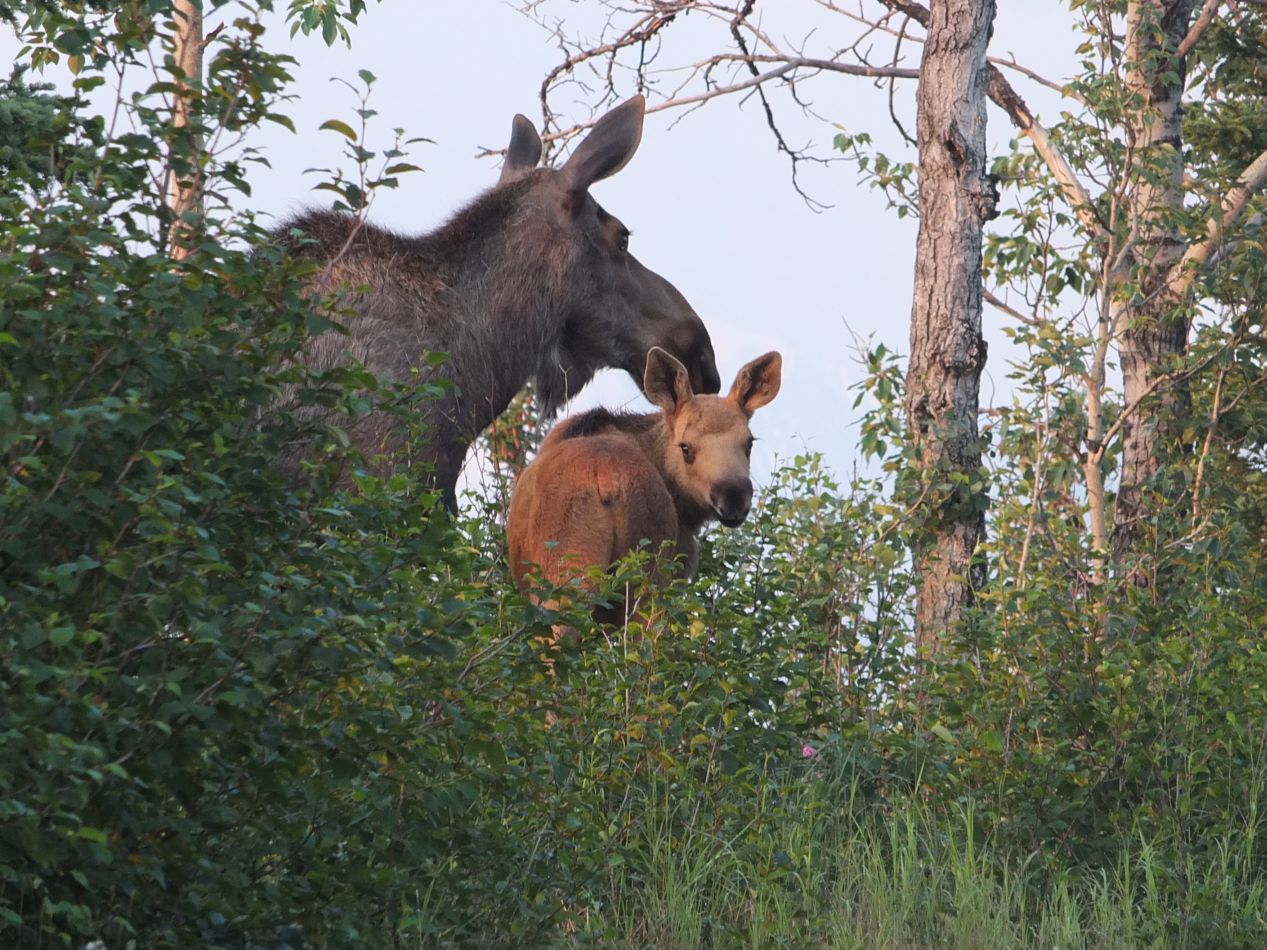


I was walking around the outskirts of the Wonder Lake campsite, only to turn a corner and stumble right into two moose! It was a moose cow and her calf, out eating some of the vegetation in the early morning. A lot of animals are active very early in the day and again at dusk, and it appeared that I had lucked into this animal encounter at just the right time. The moose were close to me, probably too close at barely 100 feet away. Running into a cow with her calf was also potentially dangerous, as she could become spooked and feel the need to defend the youngling if she felt threatened. The last thing I wanted was an angry moose chasing after me. Rather than heed the course of wisdom, however, I froze in place and continued to snap pictures of the pair, even following them slowly at a distance as they ate their breakfast. The moose were clearly aware of my presence, repeatedly shooting glances in my direction and staring right at me whenever I made noise. Fortunately they didn't do anything more than stare, and I guess they didn't feel threatened. Moose are funny creatures to look at, a little bit like huge deer but gawky and awkward in their movements. The calf in particular was absolutely adorable, clearly only a few months old and tagging along with its mother for protection. I had been fortunate enough to see a moose once before on the other end of the continent in Cape Breton Highlands, and this experience blew that out of the water. These two moose were closer and in clear view with no intervening tree cover. Eventually, the two moved off into the forest and I wasn't foolish enough to try and follow them there. What a lucky find to run across this pair in the early morning light!

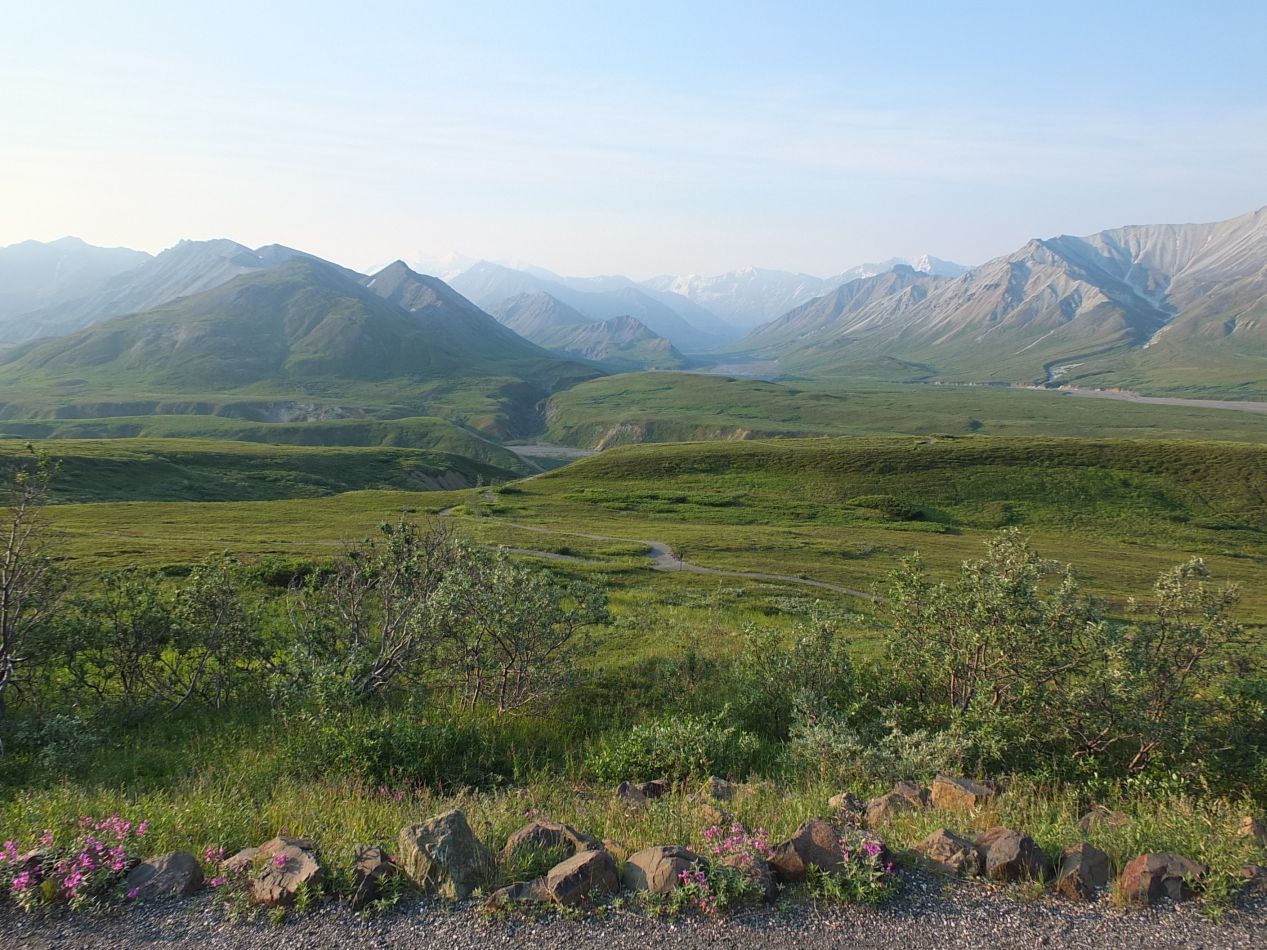


The return trip on the camper bus was subdued in nature, with the seats mostly empty and everyone on board still sleepy. I dozed for much of this trip, although I did capture some more images from Eielson Visitor Center where the early morning sunshine cast the landscape in soft tones. The weather was bright and clear once again, another perfect day to be outside. Back near the park's entrance, I made one last stop to visit the sled dog kennels to see the animals that provide transportation to the park staff throughout the winter. There are very few ways to get around once the snows start falling in Denali, and sled dog teams remain a crucial and honored form of transit. The park keeps about three dozen of these sled dogs (which are adorably referred to as "canine rangers") and takes very good care of them. There were also several litters of puppies here that were cute beyond words as they nursed with their mothers. The dogs all seemed to be Huskies or similar breeds, dogs well suited to the Alaskan climate. This was a lighthearted way to end my experience at the park.
Overall, I recommend visiting Denali in the highest possible terms. Posting some of my pictures of the park doesn't do it justice; this is an amazing place and completely worth the difficulty of reaching the entrance. Short of climbing the mountain itself, I couldn't have gotten a much better view of Denali's incredible size and splendor. From here, I would be heading next to Fairbanks, and from there, up into the Arctic itself.



